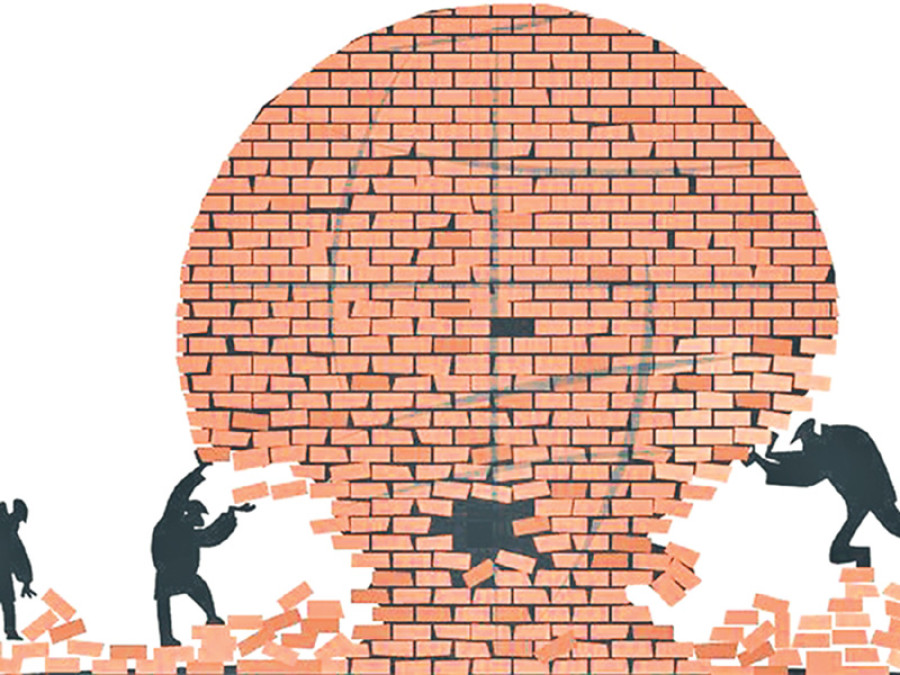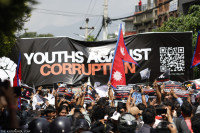Opinion
Reconstruction impasse
Almost 23 months have passed since the earthquake of April 25, 2015; yet many victims are still living under tarpaulins and temporary shelters.
Narayan Marasini
Almost 23 months have passed since the earthquake of April 25, 2015; yet many victims are still living under tarpaulins and temporary shelters. The effects of such disasters are hard to overcome in a country that lacks swift administration and locally-elected representatives. Common people have felt this inefficiency keenly. Now, Nepalis are sceptical about the National Reconstruction Authority’s progress on the reconstruction of around 800,000 private houses.
It bears mentioning that despite flaws, emergency activities (search, rescue and relief missions conducted post-earthquake) must be acknowledged. The prompt response by security forces indicated that some level of preparedness training had been conducted to safeguard against potential disasters. This foresight was showcased by regular training programmes focusing on emergency search and rescue, knowledge dissemination regarding health services, and the readily available emergency tools and materials within security forces.
Reconstruction guidelines
Common grievances today are that reconstruction has been delayed and the second tranche of reconstruction aid has not been disbursed to beneficiaries. These issues have led to the appointment of a new CEO in the NRA in January. However, simply changing the leadership will not ensure quick results. It will take time to establish new structures that can be implemented in a feasible manner. Of course, the former leadership was not totally ineffectual; in the past one year, the NRA accomplished the challenging task of establishing administrative management by developing new structures and producing necessary policies for effective reconstruction. Despite such coordination and collaboration among different stakeholders, a lack of commitment resulted in various weaknesses.
Another thing that was remiss in the construction campaign was an efficient framework on recovery activities. This created considerable confusion about the roles and responsibilities of various stakeholders. Reconstruction is a slow process; it is almost impossible to build 800,000 houses within two years while following proper safety guidelines. However, the government must ensure that the people do not suffer additional hardships in the interim. To prevent these hardships, there was a need for proper implementation of the disaster management recovery programme; however, Nepal did not follow this procedure. It jumped directly into reconstruction. The problem now lies in the fact that stakeholders are sceptical about the restriction and safety measures applied in reconstruction efforts. They fear that the reconstruction guidelines are adhered to only on paper.
Recovery programmes should have provided quake victims with housing in the form of temporary shelters for one to two years, but this never happened. The mandate of the Ministry of Home Affairs (MoHA) was formed in 1982 and is based on the Natural Calamity Relief Act. Though the mandate was well implemented post-earthquake, the absence of agencies to implement recovery programmes proved to be a shortcoming.
Mobilising personnel
Following the change in NRA leadership, a few important decisions have been made. The new leadership must expedite programmes that, in the past, were either incomplete or delayed. In addition, some new structures and programmes must be devised so that the change in leadership can be justified. Perhaps this is why the government has decided to mobilise technicians from the Nepal Army and the Armed Police Force to assist in reconstruction. In addition, the NRA has decided to conduct a month-long campaign by mobilising final year engineering students to assist in reconstruction efforts. However, questions as to whether these acts will actually support the reconstruction process remain. Our security personnel have never received structured training on earthquake resistant construction, casting doubt on the assumption that reconstruction will progress effectively after security personnel are deployed. Moreover, considering that the NRA has not been able to effectively mobilise its current field engineers throughout the villages, it is questionable whether mobilising engineering students will be effective for reconstruction.
So far, Central Level Project Implementation Unit (CLPIU) and District Level Project Implementation Unit (DLPIU) engineers under the Building Department have received Training of Trainers (ToT) on the Private Housing Reconstruction Technical Inspection Procedures (Inspection Standard Operating Procedures). Now the main priority for the NRA is to expedite this training for DLPIU field engineers so that the housing aid can be distributed after conducting necessary inspections. The NRA has not formulated either a technical guideline, or a document on the grant distribution process regarding retrofitting work for which the government decided to give identified beneficiaries Rs100,000. Similarly, our Nation Building Code (NBC) and type design recommended by NRA do not include the dry stone masonry construction mainly practised in high mountain areas in the northern belt. Documents such as these should have been developed and published a while ago to ensure that the grant would be utilised effectively.
There is also a huge complaint about the lack of DLPIU engineers stationed at the VDCs. In reality, the engineers should have been mobilised regardless of whether or not reconstruction processes were underway. They should be encouraging people in their rebuilding efforts, and should be providing technical assistance for the construction of houses in villages. If the engineers are mobilised after the rebuilding process starts, they will only be present for inspection of houses and the distribution of aid. Thus, reconstruction cannot be expedited and the reconstruction of strong houses will be in doubt.
Loss of opportunities
The current NRA leadership has expressed the loss of an opportunity to address the issue of reconstruction of integrated settlements. Perhaps future generations will condemn us for not being able to take advantage of this opportunity. Had we prioritised the construction of integrated settlement from the start, we could have relocated people from remote areas to more accessible locations, better enabling the government to deliver services. However, one must note that although the sentiment behind integrated settlements is noble, it is also related to other dimensions of development. People have to be open to relocation for such programmes to succeed.
Therefore, to establish and follow such approaches, it is essential that there is stable leadership in the NRA. Moreover, it would be a huge mistake if the current government does not implement the processes developed to ensure safe housing construction and focuses on cash grants instead. This would raise questions about the existence of the NRA itself. We would miss a golden opportunity to construct safe houses and be condemned by future generations.
- Marasini has a PhD from Ehime University, Japan




 11.12°C Kathmandu
11.12°C Kathmandu










